Hi, long time reader, first time poster. Really struggling to get the hang of baking sourdough loaves. I've been baking pizza and focaccia with my starter for a while now with great success but the loafs are always a complete disaster. This time I was so happy with the strength of the gluten built up during bulk ferment but the loaf just completely fell apart in the final rise & bake.
Any guidance would be much appreciated!
My goals for the bake:
- Small loaf
- Fluffy, moderately open crumb
- Thin but crispy crust
- Avoid burnt bottom
Method:
- Dissolved starter in water, incorporated flour and left covered for 30 minutes
- Laminated, spread over the salt and gently kneaded for 2-3 minutes
- Bulk fermented with gentle coil folds every 30-45 minutes with wet fingers (probably added a decent amount of water to the dough in this way)
- Original plan was to ferment for 12 hours in the cool box but quickly realised it was fermenting faster than anticipated so did the final 6 hours in the fridge
- Poke test passed at 12 hours (dough was sticky but a gentle poke with a wet finger sprung back slowly leaving behind a small dent)
- Very gently shaped in a dusting of flour
- Struggled a little to seal it after shaping. With the slight dusting of flour it wasn't adhesive enough to stick properly so had to repeatedly squeeze the seals
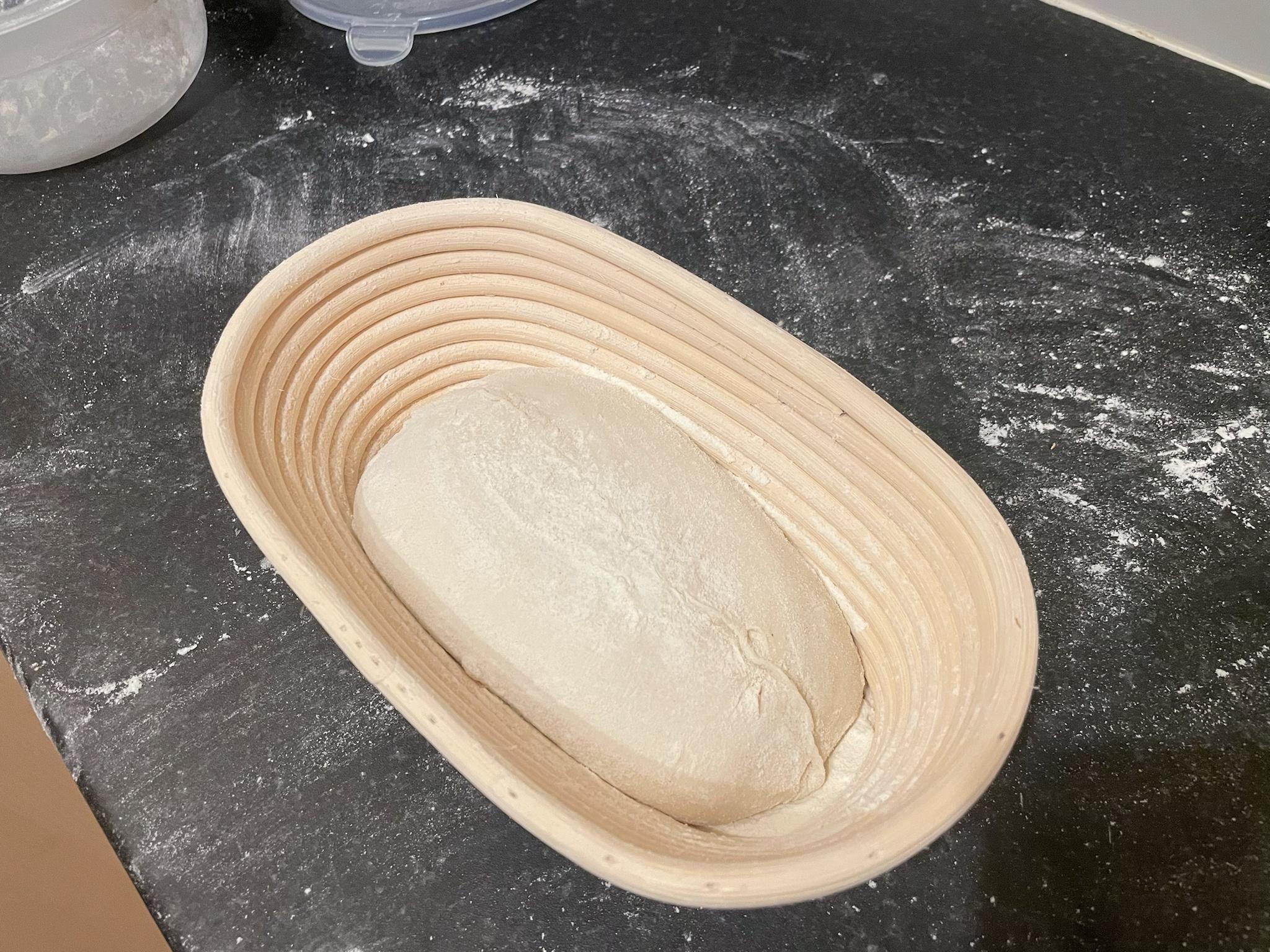
- 12h final rise in the fridge
- Loaf stuck to the banneton slightly at once side so stretched itself long and thin when removing onto parchment
- Loaf was VERY soft and delicate - flattened within seconds of being removed from banneton
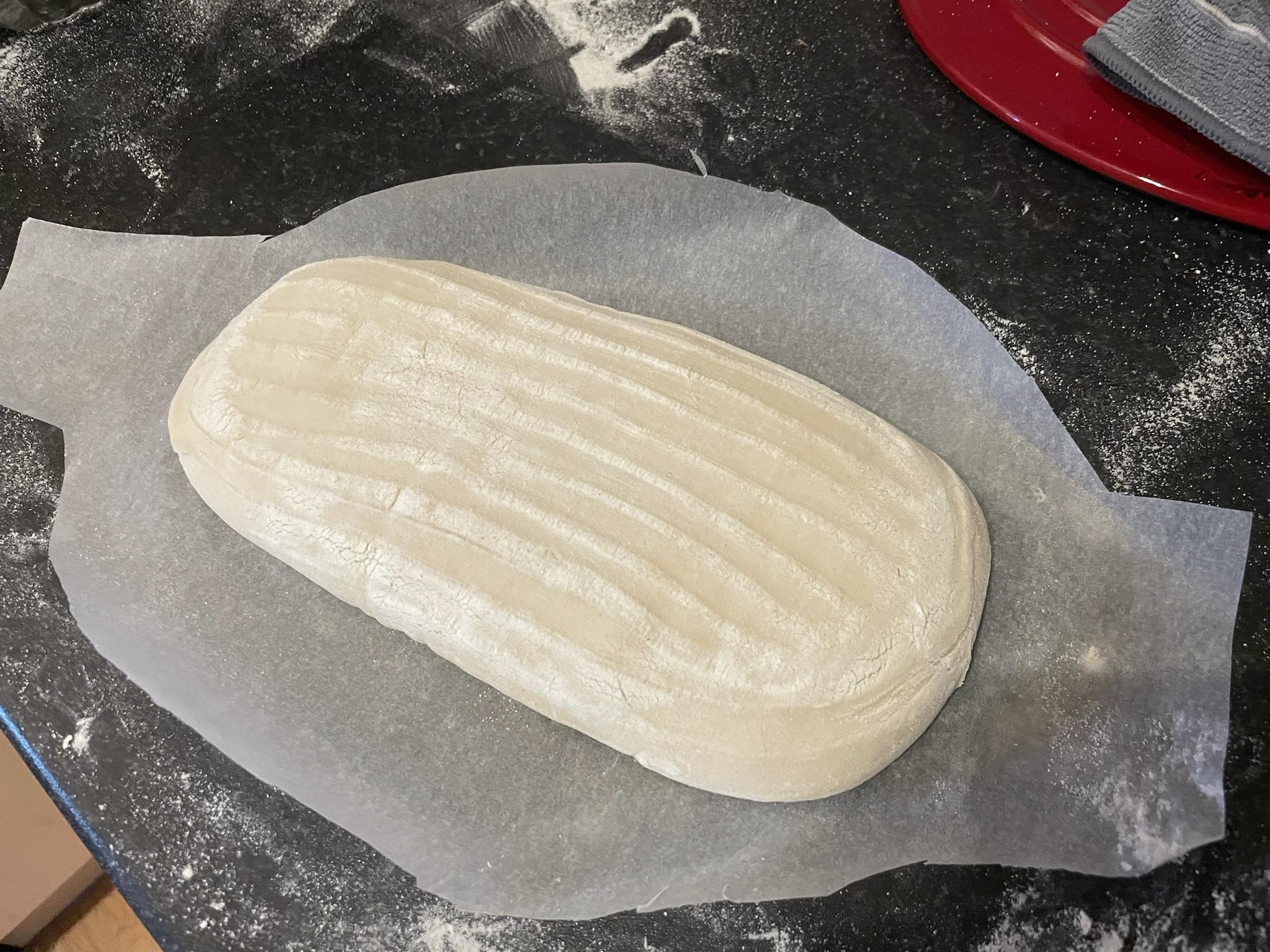
- Dusted off excess flour and spritzed with some water
- Scored with the sharpest blade I have but it was very sticky and the score re-sealed itself almost instantly
- Lowered into a cast iron pot which had pre-headed for 1h at the hottest my oven will go (c.240C)
- Turned down oven heat to 220C and baked with lid on for 15 minutes
- Removed from pot and baked on a rack for a further 15 minutes
- Pulled out a few minutes early as top was starting to burn
- Left to cool on a rack for 2 hours before slicing
Overall, I'm very disappointed with the result:
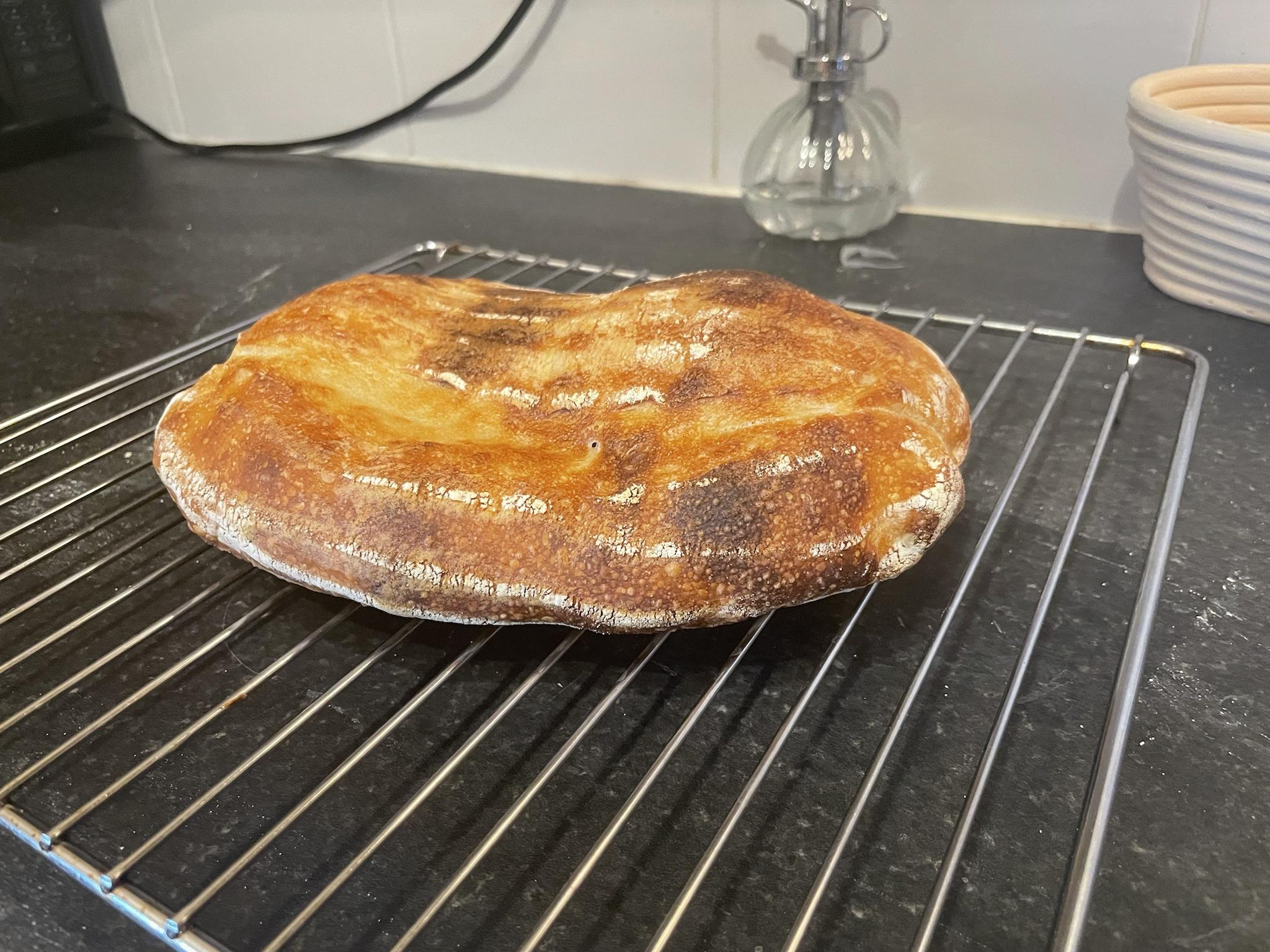
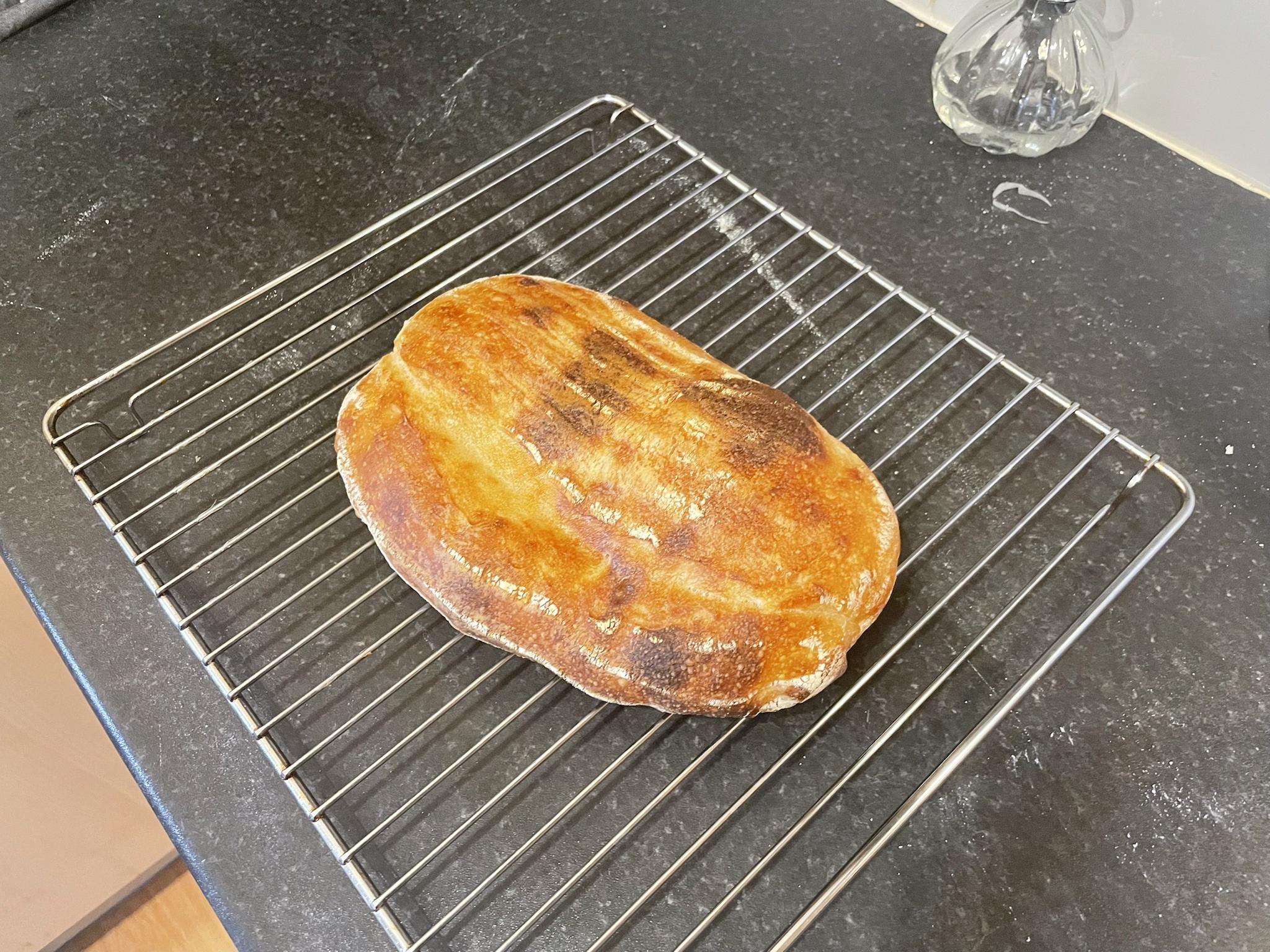
It is a misshapen flat mess. I wasn't expecting a huge, ballooned loaf because it wasn't a particularly big loaf relative to the size of the banneton so it was always going to be a bit long and short but this was not what I had in mind!
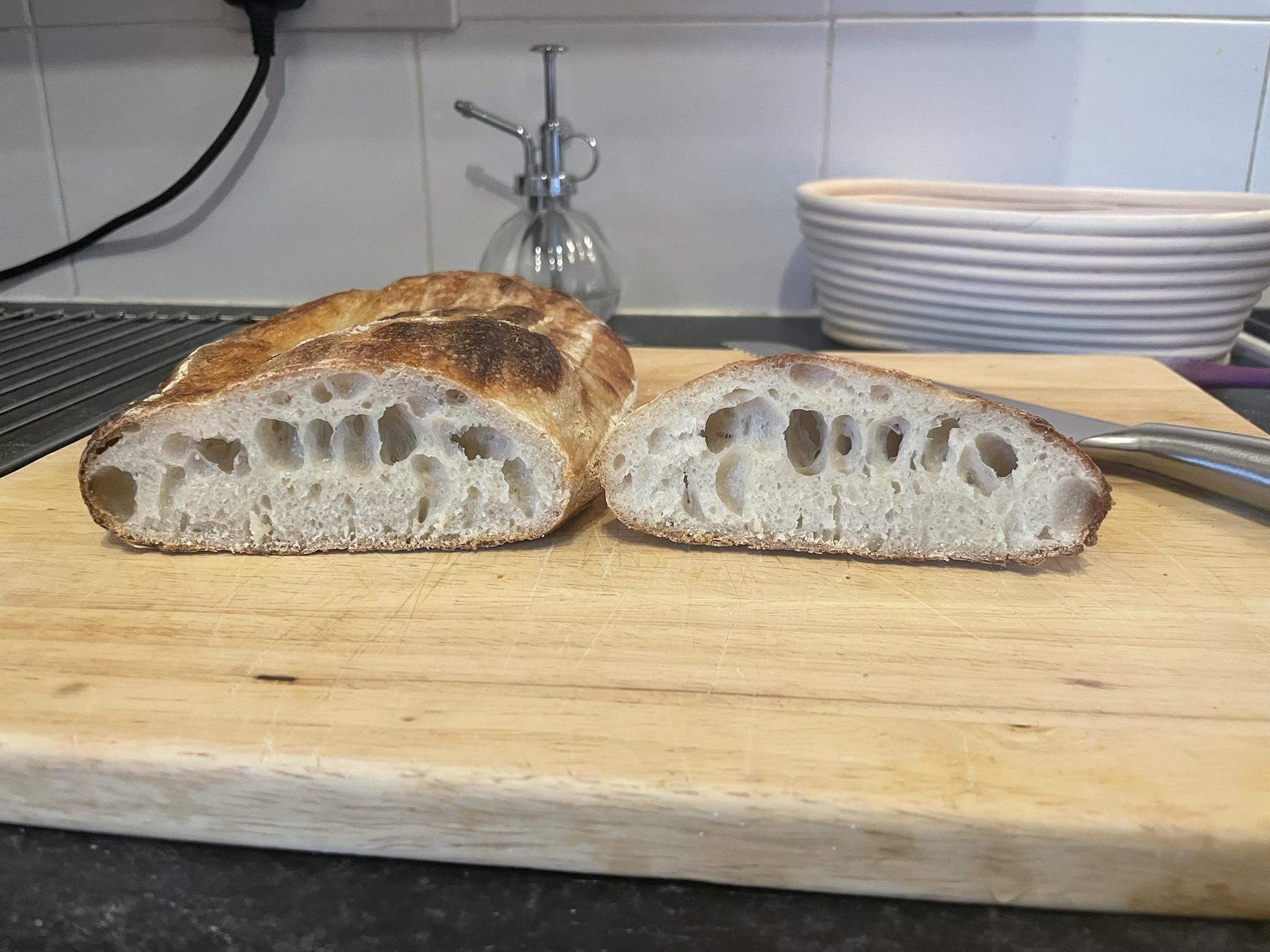
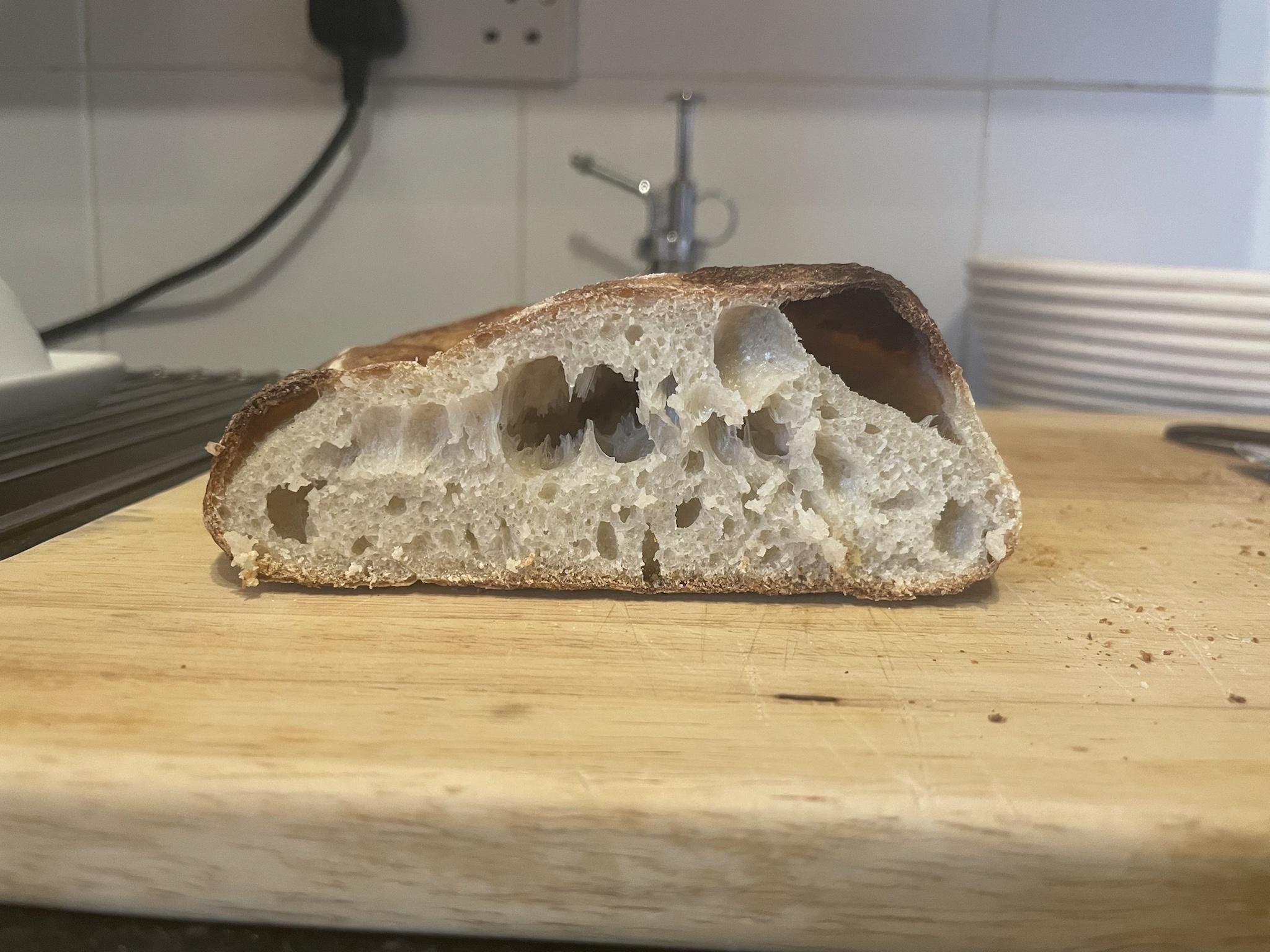
The crumb is very dense and gummy but with huge caverns within it.
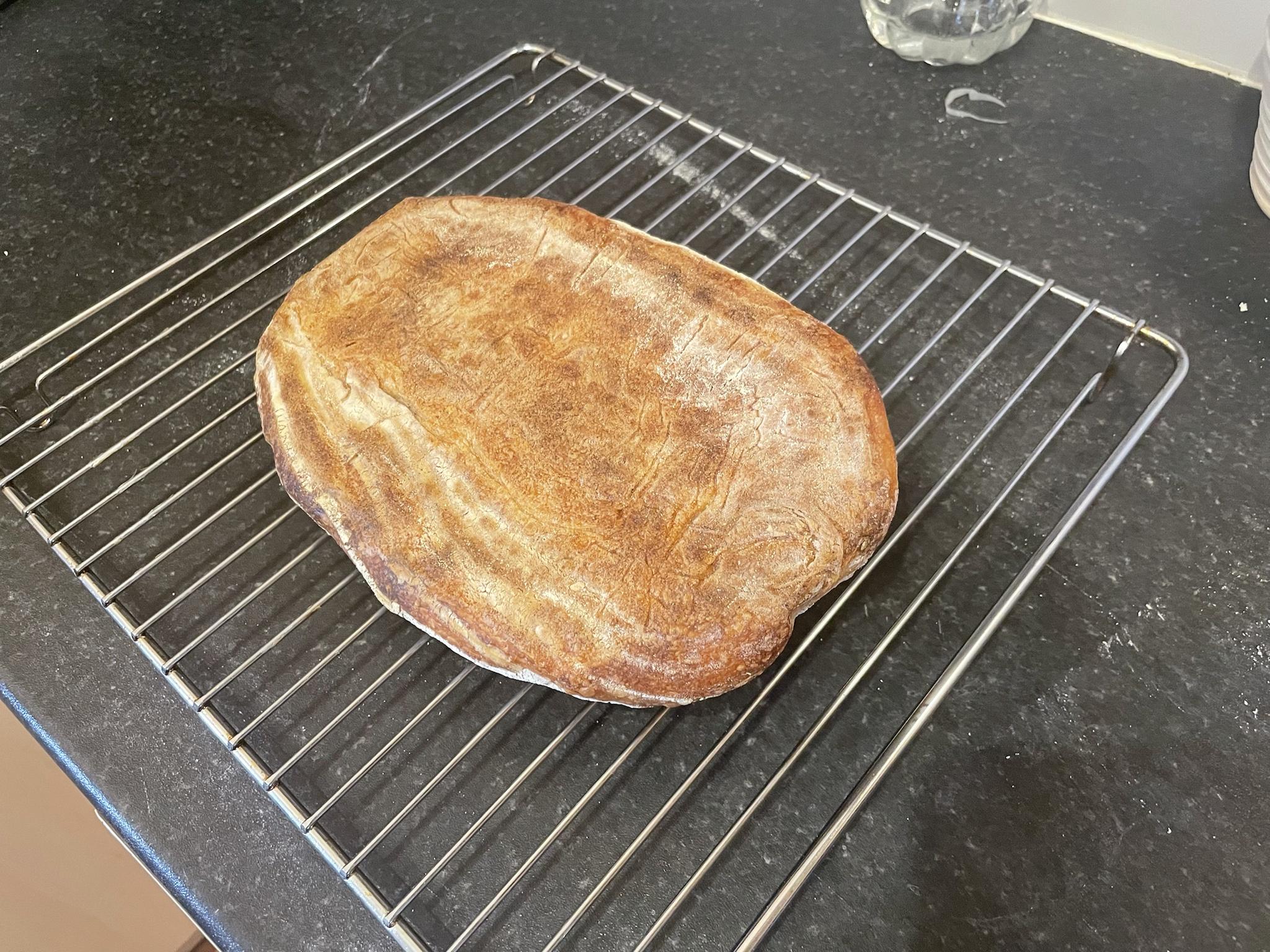
The only area in which is was successful was I managed (for the first time) to avoid a burnt bum by removing it from the pot for the final stage. The crust is reasonably crispy without being too thick or tough too which is OK.
Is this just a case of badly over-fermented? I'm surprised that it over-fermented so much with just 3% starter and it mostly being fermented in the fridge.
Have I made any other glaring errors that I need to correct in order to reach my bake goals?
Welcome to TFL.
It's important to know what country you are in and exactly what brands and types of flour you are using.
TFL has users from all over the world. Flour is different the world over. Different flours require different recipes and handling.
Also please describe the starter maintenance routines and how it reacts to feeding, such as feed amounts (by weight) and how long it takes to double/peak, and how long it has been since it was created, and how long it has been since it has stabilized.
If you can, please link to the online recipe/formula that you are using, or please give book title and page number if it is from a book.
As a beginner, it is best to follow an established/published recipe specifically designed for the types of flour in your area or country. Using foreign recipes with local flour, or inventing a recipe as a raw beginner usually leads to disappointment and frustration, making a lot of loaves before a good one is achieved.
--
Usually, some user from your country will give advice on what flour to use, or to avoid, and suggest a formula.
--
As a quick-n-dirty diagnosis ...
--
Bon chance and bon appétit, amigo.
Thanks for the quick response!
I'm from the UK and was using Sainsbury's Strong White Bread Flour. Unbleached white flour, 13.4% protein.
I wasn't following a specific recipe really. I calculated the ratios myself in an excel spreadsheet. My aim was to use a high hydration for a thin crust and a slow fermentation + small levain % to give plenty of time for flavor to develop. My favorite pizza recipe is similar (small amount of levain but 24 fermentation at 17C).
Interested that you feel too much water was added. The dough felt quite strong and robust after the bulk process and held it's shape quite well, despite being a very sticky wet dough. However, after the final rise it was VERY soft and sticky. Maybe it was too wet!
I'm also surprised to hear you think it was under-fermented. My original plan was to ferment it at 17C for the full 24h but after just a few hours of the bulk process it was growing like crazy. It had lots of air bubbles forming on the surface of the dough and just in the 30-45 minutes between coil folds it was increasing in size by c.50% each time.
I actually deliberately slowed the fermentation down for fear of over-fermentation and moved it out of the cool box into the fridge. Perhaps that was a mistake and it wasn't fermenting as fast as I thought?
I forgot to add my starter routine.
I discard to 10g starter and feed with 20g water 20g flour.
It'll peak in about 6-8 hours if left on the counter and I will try to do a counter feed before I bake with it.
The rest of the time, I leave it in the fridge and feed every 4-6 days.
I would add to Dave's diagnosis above that your banneton looks too large for your loaf.... So on top of (at least) underfermentation and other potential issues, the loaf is not supported on the sides adequately during proofing and flattens out.
I think you are right there. I reduced the doughball size but 200g compared to my last attempt as I often don't need as much bread as is produced by and 800-1000g dough ball but that was probably a mistake!
I agree that the crumb is very typical showing the dense crumb and caverns of under fermentation. Keep in mind that the poke test is useful for warm dough and isn’t indicative of well proofed dough when it is cold. I also agree that the banneton is a bit large for that mass of dough, although the fact that it is under fermented exaggerates that.
You don’t mention or I didn’t see the length of bulk and also the temperature you did bulk at.
Benny
Thanks for the advice. Bulk was 12 hours. 6 hours in the cool box at c.17C and 6 hours in the fridge.
Assuming your levain was at peak and very active then that isn't warm or long enough for it to have fermented enough before putting it in your fridge assuming your fridge is 4*C or lower.
"My aim was to use a high hydration for a thin crust and a slow fermentation + small levain % to give plenty of time for flavor to develop. "
I'm all for playing mad-scientist and experimenting. But why re-invent the wheel as a beginner?
There are already established recipes/formulas that can achieve your goals. Free ones, online. No expensive books needed. Once you have a successful bake, then it can make sense to break out on your own... tweaking this-n-that.
It's also easier to use bread dough for pizza, than using pizza dough for bread. Pizza has a looser/wider range, and less demand on the dough. As someone probably said "Failed bread dough makes excellent pizza/focaccia." But dough optimized for pizza is not conducive to good _loaf_ bread, as you have now discovered. ;-)
Yeah, you are right. I did follow a recipe for my first few bakes that had varying degrees of success. I didn't enjoy how most sourdough recipes deliver a very thick, chewy crust that's hard work to eat.
I also burnt the bottom every time as it was in contact with the iron pot the whole time.
That's why I started experimenting.
Do you happen to know a good recipe I can follow that aims for a thinner crust? That would probably be a good place for me to start!!
Baguette, ciabatta, and I think pane frances (sp) are known for thin crust.
Even for boule/batard formulas, using more of a medium protein flour, 10.5 to 11.7% range, along with creating good gluten development also seems to be a part of those thin crust loaf recipes.
To use up your high protein flour, it may take vigorous extensive kneading, machine mixing, or slap-and-folds (French folds, ala Bertinet) to work the gluten enough to get a thin or thinner skin.
--
We'll have to call upon the UK bakers to recommend any specific recipes for thin crust loaves with UK flour. Users Albacore and mwilson come to mind.
--
To avoid bottom-burning, one method is to put a large sheet or pan on the bottom rack of your oven, and then place the dutch oven on the next rack position up. This prevents direct radiant heat (like sunshine) of the lower heating element from over-heating the bottom of the dutch oven.
Another way is to sprinkle some corn meal or gritty semolina on the bottom of the DO and place the parchment paper over that, so it insulates the bottom of the dough just a bit.
I started around 60% and then gradually worked my way to 70% which I feel is a good compromise for the quality I want and ease of handling the dough. I have seen quite a few frustrated folks because they were told that quality bread needs 75% hydration.
Baked this morning this is my 70% hydration bread, 2 hour bulk ferment and then retarded about 30 hours in fridge, too early for a crumb shot. 500° degree oven lowered to 425° when bread is loaded, covered with Dutch Oven for 20 minutes then 25 minutes to finish.
I would go back to basics and keep it simple - double fridge rests will give you double the unknown - and there's enough of those in breadmaking already.
Lance
Thanks for that. I'll definitely tweak my methodology as suggested.
What do you mean by double unknown when talking about the fridge? I've used fridge or cool boxes generally for other doughs because the temp is more controlled vs the air temperature in my kitchen which can vary a fair bit.
Need to get myself a straight sided proofing container for sure. My round ones make it tricky to judge.
One question about that: when I do stretch and folds etc. the dough naturally tightens up and degasses a little again. How do I judge the bulk fermentation when I am continually deflating the dough?
You did some of your bulk in the fridge and also your final proof.
Whenever you use the fridge it is a variable - fermentation doesn't stop instantly the dough goes in the fridge. Dough temp, fridge temp, fridge cooling capacity, introduction of other foods, door openings, weight and shape of dough, dough container insulating effect and so on all affect how much fermentation takes place in the fridge.
Better to do just bulk in the fridge or just final proof to reduce the variables somewhat. Or indeed, you don't need to use the fridge at all - lots of good bread is made with ambient bulk and proof. Time planning and dough scoring are probably the main issues with that method.
Lance
You don't need to fold the dough all the time. It's usually only done a few (e.g. 3 - until the dough is strong) times in the beginning, and then it can be moved to a straight sided container and left alone. Due to the lag phase there isn't much growth in the beginning, so you won't have a big error in estimating the growth.
You are doing so many things right, it is amazing that it comes out so bad!.
That Flour is fine. Hydration is actually fine for that JS flour. To be safe, Knock it back to 70 for now?
Once you have a decent rise, you can go back up to 75-80% no probs but first we need to get out of the brickworks😂.
Problem 1, as someone said - too little starter (for now) : 100-150g of very active starter is a safe bet.
Problem 2, As someone also said - Over proofed - is it sticky/flat because it is “over the hill” ?
Bulk ferment only needs to be 2-3 hours with 4x stretch & fold.
Problem 3, As someone else said - the banneton is too big. Mix_Vol +100% max, is my rule of thumb.
Then a overnight cold rise to mix_vol +70-80% is plenty. Any more and you risk getting poorer spring and less overall rise.
If you do not over proof it, in a pot like you are using, sprung_vol / risen_vol >1.7 is reliably achievable with that flour, giving sprung_vol/mixed_vol of about 3, but …
Problem (?) 4, Leave the lid 25 mins not 15, to be safe.
These tweaks will not take you to the optimum but they will take you to a safe baseline to tune from.
This loaf will have h/D of at least 0.5
He said … 🤞
Hope this helps.
That's really helpful feedback, thanks.
I think some of my errors stem from the pursuit of a nice, thin crust. I read that higher hydration can help with this, as does lifting the lid off sooner as there is less time for steam to drive more of the dough towards the crust to thicken it.
I find it really hard to judge the fermentation of my SD. I get a very 'bubbly' dough really soon where I'm finding large bubbles appear on the surface of the ball as I do coil folds etc. That tells my brain that it is fermenting quickly. Additionally, when I put the dough ball in the container, the glutens relax and it flattens out making it appear like it has increased in volume even though maybe it hasn't. My dough is also incredibly sticky after bulk (can't handle it without wet fingers) and very delicate after the final rise which suggests it has fermented a lot.
However, the final baked result screams under-fermented, doesn't it? Dense at the bottom, no oven spring but a few huge cavernous air pockets nearer the surface.
I'll definitely return to a much higher starter % and a larger overall loaf so it fits my banneton. I don't feel confident knowing when to end the bulk though.
Indeed, judging bulk fermentation is one of the most challenging steps in sourdough baking. Fermenting in a straight sided container where you can see the rise clearly helps a lot. Alternatively, you can try using an aliquot jar to gauge the rise of a small sample of the dough to measure the rise quite accurately.
Oh I like that second suggestion. As I just responded to another person, I have trouble judging the bulk because I'm continually deflating the dough slightly with folds to build gluten strength. If I was to just cut off a small section and allow that to sit unbothered, that would be the best measurement of the fermentation of the dough, right?
I've posted a thread on how to use an aliquot Jar have a look. Using the aliquot jar has helped me immensely. I typically aim for a rise of about 40-60% to end bulk. This is for doughs with mainly bread flour and < 30% whole grain. The higher end is good if you have amazing shaping skills and 40% is much easier to shape.
Benny
OK, thanks! I might have a few mini jam or sauce jars I can use for this purpose.
So you're not looking for doubling of the size like we do with starters? Is that because the dough needs enough time to do the final rise before it gets exhausted?
Generally no we don't want to wait until the dough doubles in size for sourdoughs. Unless your gluten is really strong there would be too much gluten degradation as the pH is falling to < 4.5 because of the activation of proteolytic enzymes.